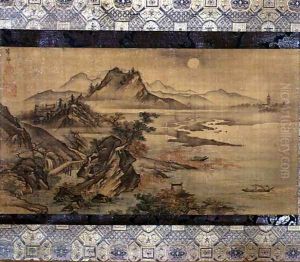Toeki Unkoku Paintings
Toeki Unkoku, also known as Tōeki Unkoku or by his given name Mori Tōeki, was a Japanese painter of the early Edo period. Born in 1591, he hailed from a period of significant transition in Japan's history, as the nation unified under the Tokugawa shogunate after a long era of civil strife during the Warring States period. Toeki was associated with the Unkoku school of painting, which was founded by Unkoku Tōgan (1547–1618). This school was an offshoot of the Kanō school, one of the most prestigious lineages of painters in Japanese history, who were known for their bold, dynamic, and innovative approaches to ink painting.
Toeki Unkoku was a disciple of Unkoku Tōgan, and he inherited the stylistic traits of his master, which included a strong emphasis on the use of ink wash and a dynamic composition that borrowed elements from the Chinese painting traditions of the Song and Yuan dynasties. This was blended with a distinctively Japanese aesthetic, which often included themes from nature, history, and literature, particularly from Japanese classical literature.
After Tōgan’s death, Toeki became the second head of the Unkoku school. He worked to spread the school's influence and was considered an important figure in maintaining the legacy of the Kanō tradition in the Western provinces of Japan. His works often featured landscapes and figures and were characterized by a bold and free brushwork that was typical of the Unkoku school.
Toeki's contributions to Japanese art were significant in terms of continuing the practices of his school and adapting them to the changing tastes of the Edo period. However, much like many artists of his time, detailed accounts of his life are limited, and much of what is known comes from the artworks he left behind and the general history of the Unkoku school.
Toeki Unkoku passed away in 1644. His legacy and the Unkoku school continued through his students and descendants, who maintained the stylistic practices he helped to perpetuate. The Unkoku school itself played a role in the development of the Rinpa school, which later emerged as one of the major schools of Japanese painting, thus ensuring that Toeki Unkoku’s influence extended well beyond his lifetime.
